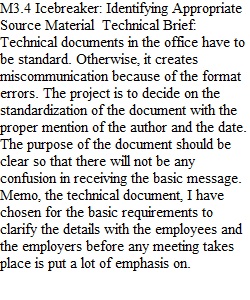


Q Whenever you’re writing academic papers or technical documents, you’ll have to identify, evaluate, and integrate appropriate source information. You won’t be able to rely solely on your own knowledge. But, often, scholarly sources—such as those you would use in support of an academic essay—may not make the cut in terms of what’s really considered appropriate for what you’re writing. Other sources—including articles from trade magazines, blog posts, podcasts, and so forth—may be more effective in helping you convey your point of view. Instructions The goal of this activity is to help you become familiar with the various types of source material that can be used in support of your technical writing. Given that you’re going to be writing a technical brief this week, we’ll use that as our starting point for this activity. While it would be useful to complete your Module Readings and review both Module Notes pages before completing this exercise, doing so is not a requirement. Step 1: Review the Situation In last week’s group discussion and collaborative memo activities, you used the following scenario: You are part of the technical writing department of a software company, and your department employs 20 different writers, editors, and graphic designers. Your department head has been talking about how challenging it has been during the last several months to produce consistent documents within the department. Given that you recently learned about the technical writing process, you have some ideas about how to improve the consistency of the documents in your department. As a reminder • the intended reader for the collaborative memo was your department head; • the purpose of the memo was to convince the department head to implement a standardized writing process; and • the document format was a technical memo. After you presented the memo to your department head, she decided to move forward with the project and has now asked you to lead a project team to implement a standardized writing process. The next step in the project is to write a technical brief that describes the project in more detail. Your department head will need to sign off on what you include in the brief before any actual work is completed on the project. Step 2: Gather Evidence and Information To ensure that you present a technical brief that provides as much evidence as possible that what you’re proposing to do is the right solution, you’ll want to gather evidence and supporting information from outside sources. Since everyone in the class is writing about the same topic, the goal of this icebreaker activity is to brainstorm different sources of information that everyone should consider. Find one source that you think meets recency, relevance, and reliability standards. Step 3: Craft Your Initial Response In your initial response, please provide the following information: • The title and author of the source you have identified • A very brief explanation (one or two sentences) of how it meets relevance, recency, and reliability standards • A very brief explanation (one or two sentences) of how the source could be used to support the technical brief you will write this week Your initial response to this activity is due Wednesday by 11:59 pm ET. You may post your response using a standard discussion reply, or you can use the built-in video recording tool in Canvas to create an audiovisual response. In total, whether written or spoken, your initial response should not exceed 150 words. Step 4: Respond to Your Classmates Review the posts of at least two classmates and respond with brief posts of no more than 50 words each (two to three sentences). Do you agree that their choice of source information is appropriate for the technical brief? Do you agree with how your classmate proposes to use the source to support the main ideas of the technical brief? Why or why not? Your peer responses are due Friday by 11:59 pm ET. Your peer responses may be posted in written or audiovisual format, and they should not exceed 50 words each. Evaluation You will be assessed using the TECH200 Icebreaker Rubric. The Icebreaker interactions combined are worth 10% of your final grade in this course. Outcomes This activity assesses the following module outcomes: • M3-01: Determine whether evidence applies to a specific technical communication situation. (CO1, CO2, CO3, CO4, CO7, CO9, CO10) • M3-02: Assess source credibility to identify the most appropriate evidence for a specific technical communication situation. (CO1, CO2, CO3, CO4, CO7, CO9, CO10)
View Related Questions